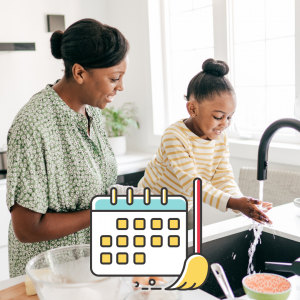I’ve researched and gathered all my experience as a mom to give you 11 actionable steps for kids to learn how to stand up to bullying.
Read on and let’s stop bullying together as a family.

#1 Create a list of Responses
#2 Build your child’s confidence
#3 Teach your children to stand up for things
#4 Teach your kid to be vulnerable
#5 Ignore the bully
#6 Make a joke
#7 Teach the importance of friends
#8 Tell the bully to stop
#9 Promote positive body language
#10 Supervise their technology and social media
#11 Report the bullying to an adult
#1 Create a list of Responses
Teaching your child at home what to say when imposing limits is very important. When bullying happens in school or on the street they will know not only what to say but how to say it (body language, intentions, etc)
Are boundaries phrases part of your kids vocabulary already? What do they say when you cross their boundaries, do they say anything?
Plan of action:
Practice this at home with your children. The same way you impose limits on them, have them do the same with you. Remember to train the exact words/phrases with the right intention too. If a kid is not looking eye to eye or it’s curved down it’s not going to pass the message.
#2 Build your child’s confidence
Confidence can be something vague but the more confident a kid is the less impact bullying will have on their self-esteem. Give attention to their hobbies, activities, or social interactions. Anything that makes your child feel good gives more intensity to that.
For example, if they like tennis, have them go through lessons, find friends that also like the sport, watch matches with them on TV. This will make them become more confident about a subject. And that confidence will spill to other areas as well.
Plan of action:
Map out hobbies, interests that your kid has. Ask them questions, learn more, encourage them to take a step further into that activity.
#3 Teach your children to stand up for things
Teach a child to stand up for things they believe is a great way to stop bullying. If kids are used to standing up for things they believe such as not throwing trash on the ground or not leaving the house dirty. They will most likely stand up against bullies and other things they don’t agree with.
If you see another child standing up for bullying in a park, talk about it with your kid. Show them the example of that approach, what the kid did good, what they didn’t do good.
Plan of action:
Figure out things for your kid to stand up for. It can be trivial stuff you and the family already stand out. Make them practice to be a good stander.
#4 Teach your kid to be vulnerable
It’s crucial for kids to identify their feelings and share them with you. It’s your job as a parent to communicate your own feelings with your kid.
The best way to teach a kid how to be vulnerable is by you being vulnerable with them.
Plan of Action:
List 5 topics you can be vulnerable with the kid, and then ask for 5 things back from them. Show them it’s okay to have problems but it’s not okay if you are not communicating them.
#5 Ignore the bully
Kids are always seeking attention, so if a kid doesn’t react to bullying it is usually the most effective way. Now to teach your child to ignore things will require an emotional intelligence skill to control his feelings.
That is something you as a parent have to analyze in your toddler, does he react emotionally to things, is he calm? By knowing what personality traits our child has, we can access the problem better.
Plan of Action:
Analyze your kids behavior, are they emotionally stable? Or they freak out over things? With that answer make a plan for your kid to control their feelings in the moment.
#6 Make a joke
Seems silly, but if a kid naturally laughs with the bully it shows confidence in who they are.
My kids did something amazing, they would naturally make fun of themselves and laugh right out with potential bullies. Interestingly enough, that would keep bullies away. Doing that deflates all the power a bully once had when they first interacted.
Plan of action:
Do you have this habit at home for the family to make fun of themselves? If not, start practicing, it will give your kids a sense of reality that none of us are perfect, and that’s okay!
#7 Teach the importance of friends
Bullies tend to aim for kids that don’t have a lot of friends or are always alone. Teaching your kids to be in service of others will eventually stop bullying. Your kid will become another parent’s eye in school for bullying.
Show your kid the importance of friendship in our lives and that he should approach somebody in school that is always alone to check on them.
Plan of action:
Sit with your kid at home and ask about their friends, how they are, what they like to do,etc. Now, ask if there are some kids at school that don’t seem to have a lot of friends. Identify what those kids are. Encourage your kid to go talk to them and see how they are doing.
#8 Tell the bully to stop
Again, coming back to our basic principle of boundaries and respect, your child will be very aware if the bully is crossing boundaries.
Standing up to bullies and telling them in a confident voice will usually work. The bully often picks on kids they can be intimidated so they will not expect someone to stand up and impose limits.
The bully often finds a victim who won’t say anything at all. So if he knows your children stand up for things, he won’t be interested in messing them or none of his friends.
Plan of action:
Does each family member have their own clear boundaries at home? What are they? Show your kids that, for example, momma has her boundaries (eg: bathroom time nobody interrupts). Dad has boundaries (eg: when he’s on the computer with headphones on try not to interrupt unless it is an emergency). The kid has boundaries as well (eg: leave toys on the ground in his room but not around the house)
#9 Promote positive body language
This is something that should be part of your parenting routine. I always give this advice from psychologist Michele Borba. Tell your child to practice looking at the color of her friends’ eyes. Now, do the same thing when she’s talking to a child who’s bothering her.
This will make your kid appear more confident, and with enough time they will have genuine confidence.
Plan of action:
Our kids are sponges and they model everything from us. Evaluate your body language and our posture. Fix what you think is wrong. Then start holding standards for your kid’s body language. How are they talking with strangers? With their friends? Show them to have the same body language no matter who the person is.
#10 Supervise their technology and social media
As our world turns digital we have to account for cyber-bullying on the internet. It’s easier to bully online.
Kids that wouldn’t have the courage to bully face-to-face now can turn to social media and bully there.
Plan of action:
When your children start to use social media, keep it curious and fun, ask them about friends in there, interactions, etc. Try to check in with them daily and also review their profile.
#11 Report the bullying to an adult
Make it clear to your child that the best way to prevent bullying is them talking to an adult. Have them understand the reasons why other kids don’t tell anybody they’re being bullied.
Be vulnerable and tell them it takes courage and strength to report bullying, but it’s the smartest way to go about it.
Plan of action:
Only have this conversation when your child is totally aware of what bullying is. You can pig back on an example of somebody who suffered bullying and emphasize that reporting is always the smartest option.
What to do next?
Well now go into action! Grab the steps talked about in this article and go apply them with your kiddos at home. A true parent is a parent of action!






